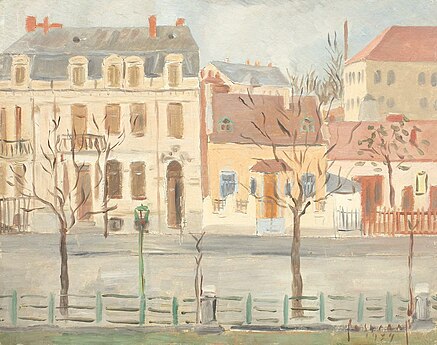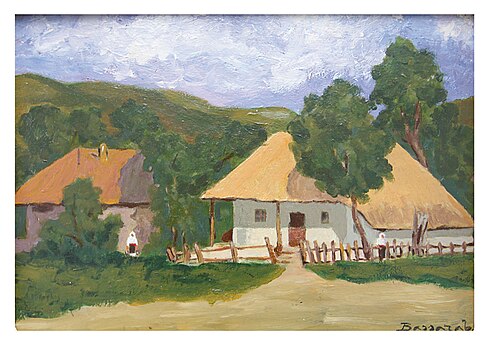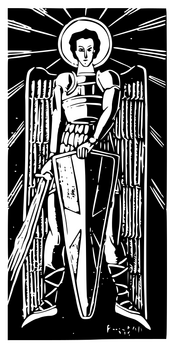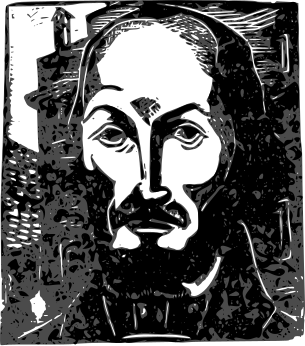Alexandru Bassarab
Alexandru Bassarab | |
|---|---|
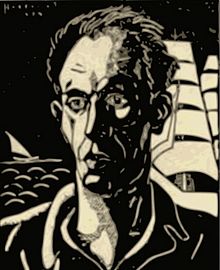 Self-portrait | |
| Born | August 7, 1907 |
| Died | July 8, 1941(aged 33) Țiganca(presumed) |
| Nationality | Romanian |
| Education | National School of Fine Arts(presumed) |
| Known for | Linocut,woodcut,line engraving,illustration,typography,oil painting |
| Movement | Arta și Omul Grupul Grafic |
Alexandru Bassarab,orBasarab(August 7, 1907 – July 8, 1941), was aRomanianpainter, engraver, andfascistpolitician. Earning his reputation for his pioneering work inlinocutandwoodcut,he explored neotraditionalism,Romanian nationalism,andRomanian folklore,and was ultimately drawn into politics with theIron Guard.He helped steer several art groups associated or integrated with the Guard, contributed to its fascist propaganda, and briefly served in theAssembly of Deputies.He survived the clampdown of the late 1930s, returning to apolitical work withGrupul Grafic,and exploring the legacy ofByzantine art.
Under theNational Legionary State,Bassarab returned to favor as one of the leading political iconographers, also urging others to contribute "epic" art in support of the regime. Arrested during thecivil strife of early 1941,Bassarab was allowed to redeem himself on theEastern Front.He died there, in mysterious circumstances, while his work continued to be censored at home.
Biography
[edit]Early life
[edit]Bassarab was born inBacău,where he graduated high school.[1]Likely a student ofIon Theodorescu-Sion's at theNational School of Fine Arts,in subsequent years he attended both the Law Faculty of theUniversity of Bucharestat the private art school run by Constantin Vlădescu, where his teachers includedNicolae Tonitza,Francisc ȘiratoandPetre Iorgulescu-Yor.[2]Bassarab debuted as a painter—in May 1931, he a still-life of his was exhibited at the Official Salon inBucharest.As noted by fellow artistMac Constantinescu,it was "sensibly treated in a palette that is both somber and distinguished."[3]He was becoming a specialist in the linocut technique,[4]also praised for his work in woodcut. He continued to exhibit canvasses at various venues but, as noted at the time by art criticAlexandru D. Broșteanu,these were "timid", far less "rounded" than his woodcuts.[5]The same was argued byPetru Comarnescu,who suggests that Bassarab "never fully mastered the interplay of colors".[6]
Bassarab joined theIron Guard,a native fascist movement, in 1932, and, as an aspiring propagandist, helped set up its artistic club, named afterȘtefan Luchian,and itsIdeea RomânieiLodge.[1]This enterprise also involved poetHoria Stamatu,who, in a retrospective letter of 1985, depicted himself as the group's theoretician. Also according to Stamatu, other members wereGeorge Zlotescu,Alexandru CiucurencuandConstantin Joja—as well as, more marginally,Ion Țuculescu,brought in by Zlotescu.[7]From October 1934, with Stamatu, Zlotescu, Ciucurencu,Ioan Victor Vojen,Dan Botta,andRadu Gyr,Bassarab was also active in the art collectiveArta și Omul.Founded as an apolitical enterprise by Tonitza, it had been taken over by Guardist intellectuals, expressing its rejection ofliberal democracyand its embrace ofcorporatism.[8]
In parallel, Bassarab's apolitical works were featured at the Official Salons. Although he failed to win prizes there, in 1934 and 1935 the Romanian state purchased a number of his engravings.[9]In early 1936, his portraits and cityscapes in various mediums were featured as a personal art show at Mozart Gallery. Columnist Alexandru Balteș was impressed by his achievements, and especially by his use of contours, "concise, somber and expressive". He declared Bassarab a "bard of the Bucharestmahala".[10]His colleague N. I. Lazăr contrarily noted that Bassarab's "Bucharest views" were less accomplished than his other work. Overall, Lazăr rated Bassarab as "still a beginner."[11]Alongside Stamatu, Bassarab worked on an edition ofFrançois Villon's ballads: Stamatu translated them, and Bassarab designed the lettering. Although the work was never printed in book form, it circulated as a rough copy among the intellectuals of Bucharest.[12]Mihail Polihroniadeused his engravings for his propaganda work,Tabăra de muncă,which came out atUniversulpublishers in 1936.[13]
As a contributor toIdeea Româneascăreview, in June 1937 Bassarab co-authored (with Stamatu, Zlotescu, andPavel Costin Deleanu), the manifestoRevoluția așezării românești( "A Revolution in Romanian Settlement" ). It declared the bankruptcy ofmodernist architectureas a staple of localized "internationalism", advocating instead for updating traditional Romanian forms.[14]According to historian Roland Clark, Bassarab and Zlotescu endure as "[the Guard's] best painters", both of them being guided by Theodorescu-Sion's neotraditionalism; all three were indebted toRomanian folklore,depicting peasants as "active, heroic figures", "dynamic, virile, determined".[15]Their art, seen by far-right chroniclers as a "purely Romanian" enterprise, was prominently displayed at the Guard's Bucharest offices,Casa Verde,during a September 1937 exhibit.[16]He was only featured there with his woodcuts, includingArhanghelul( "The Archangel" ) and a series of depictions of the Guard's main leaders.[17]Stamatu also recalls a "magnificent exhibit" of his group, held atSala Dalles"in autumn 1937".[7]Also in 1937, Bassarab and Zlotescu illustrated Neculai Totu's memoir of Guardist participation in theSpanish Civil War.[18]
Bassarab had by then joined the Guard's new legal avatar, called "Everything for the Country Party" (TPȚ), and was serving as its regional president inIalomița County—also holding a Guard rank asComandant Ajutor( "Assistant Commander" ).[19]He himself ran on the TPȚ county lists in theDecember 1937 election.According to Polihroniade's retelling of the campaign, Bassarab was able to outsmart rival politicians, in particular those of theNational Christian Party,ensuring that the results were properly tabulated. As a result, "the Guardist list took first place in Ialomița."[20]On December 4, he returned to his native city, where Guard leaderCorneliu Zelea Codreanuwas inaugurating a Christian-only consumers' co-operative, specifically boycottingRomanian Jewishmerchants.[21]
On December 15, Bassarab, Deleanu andMircea Eliadewere inȚăndăreifor the funeral of Ion Târcolea, who had been killed during the electoral showdown.[19]Bassarab himself took a Ialomița seat in theAssembly of Deputies,but lost it immediately whenKingCarol IIordered a clampdown.[1]Subsequently, theNational Renaissance Frontdictatorship kept Bassarab under close watch, documenting his participation (with Polihroniade,Ion Zelea Codreanu,and Bănică Dobre) in the clandestine Guardist reunion ofCălărași(February 1938).[22]On February 15, Bassarab married schoolteacher Elena Cantaragiu at a church inBucureștii Noi,in front of an audience which included C. Z. and I. Z. Codreanu, alongside Eliade, Polihroniade,Haig Acterian,andConstantin Gane.[23]
Political rise, downfall, and death
[edit]In February 1940, Bassarab joined Zlotescu and Valentin Hoeflich for another exhibit at Sala Dalles. Columnist Ion Zurescu noted his "daring" approach, and his growing similarities withprimitive art.[24]The clash between Carol and the Guardist leadership had by then escalated into an armed conflict. On March 17, 1940, Bassarab, like Gyr,Radu MeitaniandȘtefan Palaghiță,signed up to a letter which affirmed their loyalty to the throne, describing themselves aslegionarii de ieri( "former Guardists" ).[25]In that context, Bassarab exhibited with the collective known asGrupul Grafic,alongsideMarcel Olinescu.Their work was apolitical, heavily inspired byByzantine art—within that context, Bassarab remained the morenaturalistic,preserving elements ofperspective.[26]Founders ofGrupul Graficalso includedAurel Mărculescu,who was both Jewish and an anti-fascist.[27]
In September 1940, Carol abdicated and the Guard took over, establishing a "National Legionary State";Bassarab, Olinescu, andGheorghe CeglokoffreformedGrupul Grafic,which was now openly associated with the Guard, and exhibited at Sala Dalles.[28]Bassarab now showcased work that was highly political, including portraits of folk heroes such asHoriaalongside Guard commanders such as C. Z. Codreanu,Ion MoțaandGheorghe Clime.Ion Frunzetti,a Guard supporter and art critic, praised him as "the chronicler of a destiny", with "a certainThraciantoughness ".[28][29]On November 11, theMinistry of Artstook control over theArtists' Guild,and assigned its new leadership—with Bassarab,Oscar HanandMarius Bunescuamong the new directors.[30]Appointed to other high positions in the field of propaganda, Bassarab stirred controversy by suggesting that artists should abandoneasel paintingin favor of "epic"muralism.[31]
During that interval, the Guard accorded its assassinated and exhumed founder, Codreanu, a lavish second funeral. The ceremony was held atSfântul Ilie Gorgani Churchin Bucharest, and the entrance to the church was flanked by two giant posters of archangels, massively enlarged versions ofline engravingsdrawn by Bassarab in 1935.[32]These closely resembleNașterea( "Birth" ), another drawing by Bassarab. There, the Guard's patron, theArchangel Michael,watches over an infant at his feet. Above, a legend gives Codreanu's birthdate, giving the image a religious and propagandistic impact. Another drawing of his draws upon folklore to place Codreanu in the context of theMiorițalegend.[33]In December 1940, Bassarab organized an exhibit,Munca legionară( "Legionary Labor" ), also at Sala Dalles, which represented a fusion of art with Guardist ideology.[34]It was attended byTraian Brăileanu,the Arts Minister, and Guard CommanderHoria Sima.[35]The same venue was also hosting theAjutorul Legionarcharity bazaar, organized by Codreanu's widow. Participants includedMaria Antonescu,wife ofConducătorIon Antonescu,as well as Alexandru and Elena Bassarab.[36]
Also in December 1940, Brăileanu's own journal,Însemnări Sociologice,put out Bassarab's article,Viața legionară, isvor de creație( "Guardist Life as a Source of Inspiration" ).[37]On January 13, 1914, he was a government representative for another ceremony, held atCasa Verdein memory of Moța, Codreanu and other Guardist figures.[38]Days after, the Guardfell from power,and Bassarab was arrested on orders fromConducătorAntonescu.[1]When Romania enteredWorld War IIin June 1941 as part ofOperation Barbarossa,Bassarab was placed into a frontline unit with a high risk of casualties, participating in the recovery ofBessarabia(Operation München). He vanished outsideȚiganca.Legends began circulating that he had been killed whiledemininga field with his bare hands.[1]Another account has it that he had been taken prisoner by theRed Army,detained atChișinău,and finally slashed with a bayonet when he protested against the torturing of a Romanian officer.[39]The most likely version is that he was captured and shot at Țiganca, in retaliation for the Romanians' treatment of Soviet prisoners.[1][40]
An obituary by Comarnescu saw print inRevista Fundațiilor Regale,praising Bassarab as the "laborer-artist" who, in dying, lived up to his "heroic perspective on art": "it was given to him that he should accomplish more as a Romanian soldier than as an artist, his very sound debut notwithstanding."[6]Bassarab's propaganda work was formally banned soon afterAntonescu's downfall,as the new regime and theAllied Commissionclamped down on all forms of fascist literature and art.[18]His widow, who had a degree in philology, never remarried. She survived the rise and fall ofCommunist Romaniaand died in 1999 at age 95. Their son Șerban, born in 1940, pursued a career as a mathematician.[41]His father's work was again explored after theRomanian Revolution of 1989.In 1999, Petre Oprea republished art chronicles by Bassarab, Stamatu and Zlotescu, noting that their aesthetic hierarchies were often confirmed by posterity.[42]
Selected works
[edit]-
Primăvară pe cheiul Dâmboviței( "Spring on theDâmbovița",1934)
-
Case de țară( "Countryside Houses" )
-
Arhanghel( "Archangel" ), 1935
-
Nașterea Căpitanului( "Birth ofthe Captain")
Notes
[edit]- ^abcdef(in Romanian)Iurie Colesnic,"În culisele Istoriei. Un pictor căzut la Țiganca",inTimpul,February 8, 2014
- ^Teacă, p. 200. See also Clark, p. 192
- ^Mac Constantinescu,"Rubrica plastică. Salonul oficial. Pictura", inCuvântul,May 6, 1931, p. 2
- ^Scăiceanu, p. 384
- ^Alexandru D. Broșteanu,"Cronica plastică", inGândirea,Issue 4/1936, pp. 214–215
- ^abPetru Comarnescu,"Note. †Al. Basarab", inRevista Fundațiilor Regale,Issue 5/1942, pp. 467–468
- ^abAlexandru Lungu, "Între semn și cuvânt (Răsfoind scrisorile de la Horia Stamatu)", inVatra,Vol. XXVII, Issue 343, October 1999, p. 56
- ^Ioan Victor Vojen,"Prefață pentru o activitate viitoare", inArta și Omul,Issues 16–17/1934, pp. 236–238
- ^"Caleidoscopul vieții intelectuale. Litere, știință, artă. Premiile și cumpărăturile la Salonul Oficial de desen și gravură", inAdevărul,December 1, 1935, p. 2; A. B., "Note și informații", inArta și Omul,Issues 16–17/1934, p. 264
- ^Alexandru Balteș, "Expozițiile. D. Ciucurencu. I. Negrulea, A. Bassarab, D-na Tacian Baludima", inArgus,February 15, 1936, p. 3
- ^N. I. Lazăr, "Cronica plastică. La 'Universul', I. Panteli-Stanciu. La 'Mozart', Ciucurencu și alții", inȚara Noastră,February 21, 1936, p. 2
- ^Octav Șuluțiu,"Cronica literară: Zoe Verbiceanu,Baladele lui François Villon",inGândirea,Issues 3–4/1941, p. 195
- ^Clark, p. 195
- ^Arșavir Acterian,"Fapte și idei.Revoluția așezării românești",inVremea,Vol. X, Issue 492, June 1937, p. 10
- ^Clark, pp. 192–193
- ^Clark, pp. 182, 193
- ^George Nichita, "Cronica plastică. Expoziția grupului 'Luchian'", inCurentul,October 19, 1937, p. 2
- ^ab"Deciziuni. Comisiunea română pentru aplicarea armistițiului. Comunicat", inMonitorul Oficial,Issue 129/1945, p. 4857
- ^ab"Inmormântarea legionarului Ion Târcolea, ucis la Sâveni", inBuna Vestire,December 20, 1937, p. 5
- ^Mihail Polihroniade,"Campania electorală. 'Minunea' de la Călărași'", inBuna Vestire,November 25, 1937, p. 1
- ^I. Stoenescu, "Ultima Oră. Batalionul comerțului legionar începe bătălia în Moldova cotropită de jidani. Față'n față cu dușmanul. Deschiderea consumului legionar de la Bacău. Cuvântul Căpitanului", inBuna Vestire,December 5, 1937, p. 6
- ^Valentin Gheorghe, "Activitatea legionarilor dâmbovițeni în timpul monarhiei autoritare carliste (1938–1940)", inCollegium Mediense III. Comunicări Științifice, XII: Istorie, Arheologie, Științe Politice,2013, p. 105
- ^"Ultima Oră. Căsătoria pictorului Alexandru Bassarab", inBuna Vestire,February 16, 1938, p. 6
- ^Ion Zurescu, "Cronica plastică", inRomânia,February 10, 1940, p. 4
- ^"Uniți în jurul M. S. Regelui, toți foștii fruntași legionari se încadrează in noile orânduiri politice ale țării. Mărturisirea de credință fațâ de Tron. Apelul pentru foștii camarazi", inCurentul,March 17, 1940, p. 9
- ^Petru Comarnescu,"Note. Grupul Grafic", inRevista Fundațiilor Regale,Issue 2/1940, p. 476
- ^(in Romanian)V. I.,Aurel Mărculescu/Aron Marcovici (Piatra Neamț, 1900 – București, 1947),J-Art. Artiști Evrei din România (Center for Monitoring and Combating Antisemitism in Romania &Elie Wiesel National Institute for Studying the Holocaust in Romania)
- ^abIon Frunzetti,"Grupul Grafic (Sala Dalles)", inUniversul Literar,Issue 40/1940, p. 6
- ^Clark, p. 193; Teacă, p. 200
- ^"Curentul zilei. Noua conducere a sindicatului artelor frumoase", inCurentul,November 13, 1940, p. 2
- ^Ion Vlasiu,"Cronici. Salonul oficial de toamnă", inRevista Fundațiilor Regale,Issue 12/1940, pp. 663–664
- ^Teacă, pp. 200–201
- ^Teacă, p. 201
- ^Scăiceanu, p. 384; Teacă,passim
- ^Teacă, p. 202
- ^"Inaugurarea bazarului 'Ajutorului legionar'", inUniversul,December 24, 1940, p. 3
- ^"Însemnări Sociologice",inGlasul Bucovinei,December 9, 1940, p. 3
- ^"Arena politică. Solemnitatea prăsnuirii legionare în memoria eroilor Moța–Marin. La Casa Verde. Desfășurarea solemnității", inCurentul,January 15, 1941, p. 3
- ^Nicolae Goga, "Necrolog. Arh. Constantin Joja", inBuletinul Comisiei Naționale a Monumentelor, Ansamblurilor și Siturilor Istorice,Issue 2/1991, p. 58
- ^Morariu, p. 32; Scăiceanu, p. 384; Teacă, p. 200
- ^Morariu, p. 32
- ^(in Romanian)Mihai Rădulescu,"George Zlotescu. Un destin sfios și tragic",inContemporanul,Issue 5/2008, p. 34
References
[edit]- Roland Clark,Sfîntă tinerețe legionară. Activismul fascist în România interbelică.Iași:Polirom,2015.ISBN978-973-46-5357-7
- (in Romanian)Vasile V. Morariu,"Șerban A. Basarab",in Petre T. Frangopol (ed.),Elite ale cercetătorilor din România: matematică – fizică – chimie,pp. 32–34. Cluj-Napoca: Editura Casa Cărții de Știință, 2004.
- (in Romanian)Cristian Andrei Scăiceanu,"Activitatea artistului Șerban Zainea la Banca Națională a României",inActa Terrae Fogarasiensis,Vol. II, 2013, pp. 381–403.
- (in Romanian)Corina Teacă,"Artă și ideologie: expozițiaMunca legionară",inStudii și Cercetări de Istoria Artei. Artă Plastică,Vol. I, 2011, pp. 199–206.
- 1907 births
- 1941 deaths
- 20th-century Romanian painters
- 20th-century engravers
- Romanian engravers
- Romanian illustrators
- Romanian typographers and type designers
- Christian artists
- Romanian art critics
- Romanian columnists
- Romanian propagandists
- 20th-century Romanian politicians
- Members of the Chamber of Deputies (Romania)
- Romanian Land Forces personnel
- People from Bacău
- Members of the Romanian Orthodox Church
- People detained by the Siguranța
- Romanian military personnel killed in World War II
- Romanian prisoners of war
- World War II prisoners of war held by the Soviet Union
- Romanian people executed abroad
- Executed Iron Guard members
- Executed Romanian collaborators with Nazi Germany
- People executed by the Soviet Union
- Executed military personnel
- Censorship in Romania

